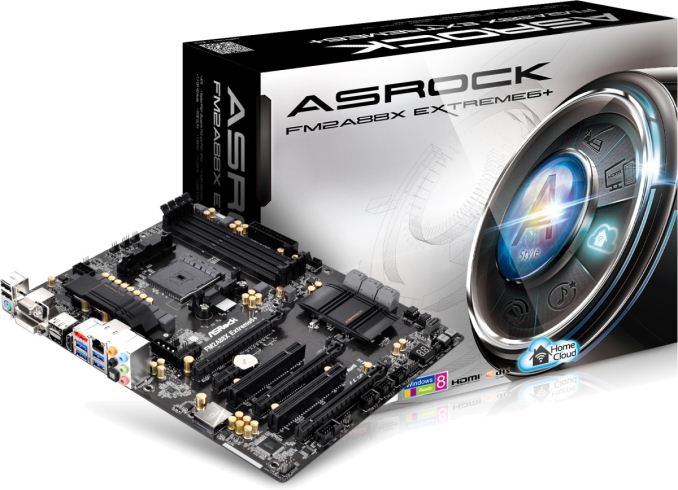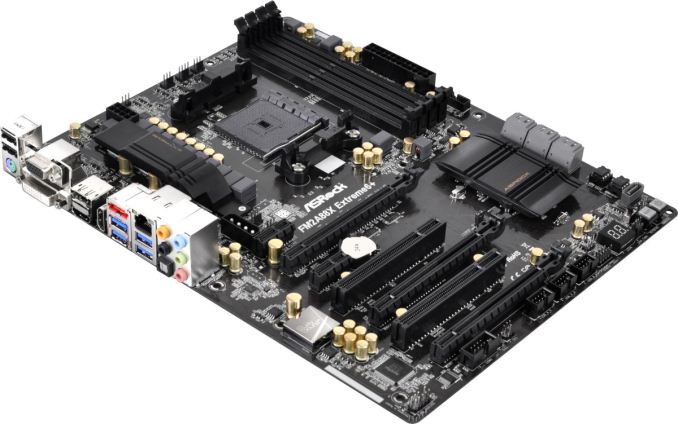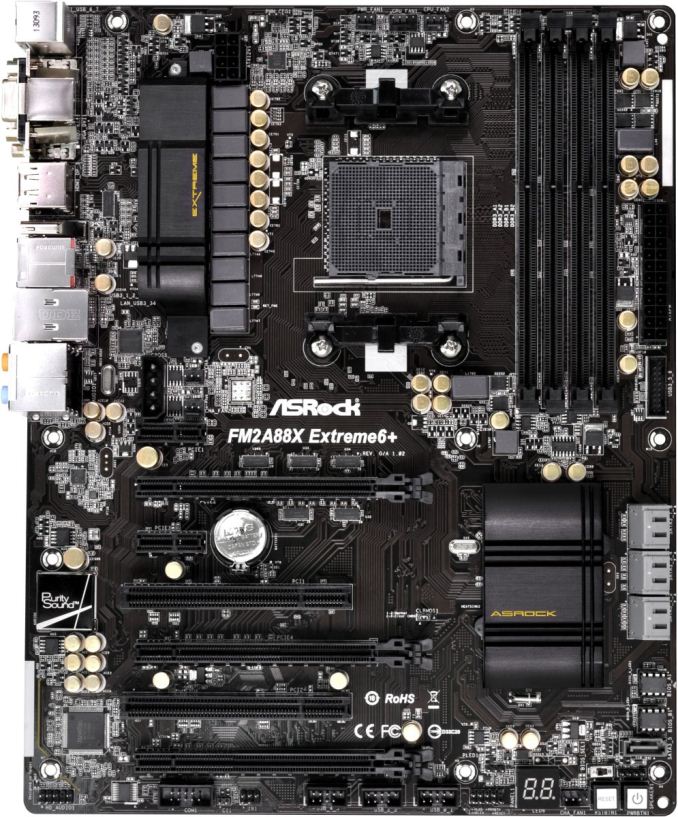ASRock FM2A88X Extreme6+ Review
by Ian Cutress on March 19, 2014 11:59 AM EST
For the
ASRock FM2A88X Extreme6+ Overview
The AMD Kaveri launch was a bit of a mêlée – two weeks to test a dozen processors in our new benchmarking suite, both in terms of CPU and IGP performance, with the big write up at the end. At the time I used the FM2A88X Extreme6+ motherboard, and in order to avoid complications I put on some rock solid air cooling and it sailed through the process. When I removed the extra cooling, a heat-related issue started to occur. I noticed the VRM heatsink getting hot, and as a result the system was reducing frequencies after extended workloads. After checking everything in the software side was OK, I got an infrared thermometer to probe some of the components. When the VRM heatsink showed 88C after 5 minutes of encoding work, and 97C after an hour, I had found the culprit of the issue. 88C is a rather high temperature, despite these components are usually rated to 105C. Since I finished testing the motherboard, ASRock has launched several new BIOSes, which I tested after consulting ASRock. The final result was that the system till reached 80C after 10-15 minutes of hard CPU work (normal work rather than a power virus) and 92C after 25+ minutes.
This might be seen a stern start to a motherboard review, especially one that has won awards elsewhere and performed well in our high-end air cooled testing. The FM2A88X Extreme6+ is a full sized ATX motherboard using the A88X chipset, supplanted with an 8+2 power phase design. From the chipset we have eight SATA 6 Gbps ports (7 regular + 1 eSATA), 6 USB 3.0 ports, an x8/x8 + x4 PCIe layout and support for up to 64GB DRAM from four memory slots. ASRock's website states that this motherboard can be part of a system that supports 4096x2400 at 60 Hz via DP 1.2. Other video outputs are present as well (VGA, DVI-D and HDMI).
ASRock’s additions to the base chipset include support up to DDR3-2600 on the memory, a Realtek ALC1150 audio codec (rated at 115dB SNR) with a TI NE5532 headset amplifier, a Qualcomm Atheros AR8171 network interface, six fan headers, power/reset buttons, a two digit debug, an ASMedia ASM1042 for two additional USB 3.0 ports and the ASRock BIOS/Software ecosystem that is ever improving.
In our performance testing, the motherboard and CPU combination trades blows with another FM2+ motherboard we are currently testing, winning in a few CPU and gaming tests. The system scores under 10 seconds for a Windows 7 POST time, although the DPC Latency is matching that of our Intel 8-series results oddly enough.
ASRock is often very aggressive on pricing, and the FM2A88X Extreme6+ comes in at $105, near other motherboards from ASUS, GIGABYTE and MSI. ASRock is continually building an ecosystem around the BIOS utilization and software functionality in order to make their products more desirable, though additional cooling on this model might be recommended.
Visual Inspection
ASRock’s 2013 livery moves to 2014 with the higher end chipset SKUs bathed in black and gold colors – the FM2A88X Extreme6+ is no exception.
The socket area has no obvious outline, but opens up the AMD socket to large coolers in all directions. The power delivery to the left of the socket gives the 8+2 configuration, although the heatsink provided is quite small with no extension or additional fan. There are five fan headers around the socket, three above (CPU 4-pin, CPU 3-pin and PWR 3-pin) and two underneath the power heatsink, both CHA 3-pin. The final fan header on the motherboard is a CHA 4-pin in the bottom right.
Moving clockwise around the motherboard, the DRAM slots are double ended latch mechanisms, although they use the thinner latches with a full sized slot. Underneath the 24-pin ATX power connector is a USB 3.0 port, followed by six of the SATA 6 Gbps ports. ASRock provides two BIOSes on the Extreme6+, both replaceable should one fail. Next follows another SATA 6 Gbps port and a BIOS selector switch.
The chipset heatsink is small to cater for the A88X chipset (~7W). The sole additional controller on the motherboard is an ASMedia ASM1042 – a USB 3.0 controller near the rear IO that does not need a heatsink.
The PCIe layout uses two PCIe 2.0 x1 small slots, two PCI slots, two PCIe 3.0 slots (in either x16/- or x8/x8 mode) and a final PCIe 2.0 x4 slot from the chipset. This final slot is designed for other non-gaming GPU PCIe devices, although it can be used for 3-way CrossFire at a lower-than expected scaling rate. For users wanting to put three power-hungry devices into the full length PCIe slots, ASRock provides a 4-pin molex connector for extra power. In my opinion, the location of this connector is frustrating, requiring cables to reach over the motherboard. Other manufacturers have utilized SATA power, or 6-pin PCIe connector, at the edge of the motherboard. This is a preferred location, as it does not require cables reaching across the system.
On the bottom of the board we have a good combination of power and reset buttons coupled with a two-digit debug LED. If I had my way, these would be on all motherboards to help with debugging issues. Also present are three USB 2.0 headers, a COM header, a Front Panel audio header, a front panel header and one of the aforementioned fan headers.
ASRock’s Purity Sound paradigm on the audio consists of a Realtek ALC1150 audio codec in an EMI shield, filter caps, a headphone amplifier and ASRock also list PCB shielding to help improve the audio signal.
The rear IO of the motherboard consists of two USB 2.0 ports, a PS/2 combination port, VGA, dual-link DVI-D, a DisplayPort, a HDMI-out, a HDMI-in, an eSATA 6 Gbps (A88X), two USB 3.0 ports (A88X), two more USB 3.0 ports (ASMedia ASM1042), an Ethernet port (Atheros AR8171), an optical SPDIF output and audio jacks.
Board Features
| ASRock FM2A88X Extreme6+ | |
| Price | Link |
| Size | ATX |
| CPU Interface | FM2+ |
| Chipset | AMD A88X (Bolton D4) |
| Memory Slots |
Four DDR3 DIMM slots supporting up to 64 GB Up to Dual Channel, 1333-2600 MHz 2600 MHz with two modules |
| Video Outputs |
HDMI at 4096x2160 (24 Hz) DVI-D at 2560x1600 (60 Hz) D-Sub at 1920x1200 (60 Hz) DisplayPort at 4096x2400 (60 Hz) or 4096x2160 (60 Hz) |
| Onboard LAN | Qualcomm Atheros AR8171 |
| Onboard Audio | Realtek ALC1150 |
| Expansion Slots |
2 x PCIe 3.0 x16 (x16, x8/x8) 1 x PCIe 2.0 x4 (A88X) 2 x PCIe 2.0 x1 2 x PCI |
| Onboard SATA/RAID |
7 x SATA 6 Gbps (A88X), RAID 0, 1, 5, 10 1 x eSATA 6 Gbps (A88X) |
| USB 3.0 |
4 x USB 3.0 (A88X) [2 back panel, 1 header] 2 x USB 3.0 (ASMedia ASM1042) [2 back panel] |
| Onboard |
7 x SATA 6 Gbps 1 x USB 3.0 Header 3 x USB 2.0 Headers 6 x Fan Headers 1 x Front Panel Audio Header 1 x COM Header Power/Reset Switches BIOS Selection Switch Two-Digit Debug LED |
| Power Connectors |
1 x 24-pin ATX Power Connector 1 x 8-pin CPU Power Connector 1 x 4-pin Molex VGA Power Connector |
| Fan Headers |
2 x CPU (4-pin, 3-pin) 3 x CHA (4-pin, 2 x 3-pin) 1 x PWR (3-pin) |
| IO Panel |
PS/2 Combination Port D-Sub HDMI In HDMI Out DVI-D DisplayPort Optical SPDIF Output 2 x USB 2.0 Ports 2 x USB 3.0 Ports (A88X) 2 x USB 3.0 Ports (ASMedia) 1 x GbE LAN (AR8171) 1 x eSATA 6 Gbps (A88X) Audio Jacks |
| Warranty Period | 3 Years |
| Product Page | Link |
The addition of a USB 3.0 controller and a high-end Realtek audio codec puts the Extreme6+ high up the product stack for an AMD FM2+ motherboard. Unlike Intel were a $400 motherboard might be common, motherboard manufacturers tend not to splash out on an AMD motherboard (with PCIe PLX switches or obscure lane allocations) purely due to demand and volume.














44 Comments
View All Comments
PEJUman - Wednesday, March 19, 2014 - link
^This^I love my kaveri ITX build:
1. it's quite capable for HTPC-NAS unified solution with the large numbers of SATA 3 out of A88X 2. $130 A10-7850K CPU+GPU pricing @ microcenter.
3. $90 ASrock A88X-ITX+ @ newegg.
Sold my ivy bridge ITX HTPC & nehalem X58 NAS. each are more capable than the Kaveri CPU. but now I run both
PEJUman - Wednesday, March 19, 2014 - link
systems on 1 kaveri system alone, saving a boatload of idle power consumption + getting more capable GPU for MADVR in the process.duploxxx - Wednesday, March 19, 2014 - link
not sure how you look at charts, but the issue with these reviews has always been to compare equal products, which is very obvious many tech sites can't. Again today this review is a mucked up comparison.Why not do a decent test with the onboard gpu and for example mantle and see the difference again, these amd series are not thrown into the market to compete on that CPU front, they are there for general purpose and mid stream market. Who ever believes he need a 4770 for general use (not all are video freaks) should think twice, but yet they can't since they are stuck in believing just benchmark results....
why?
http://www.newegg.com/Product/Product.aspx?Item=N8...
http://www.newegg.com/Product/Product.aspx?Item=N8...
309$ vs 184$
with that price difference i buy a 128Gb latest gen SSD and you know what the AMD will fly over any application while the intel with a normal HD would cripple. so useless compare of benchmarking as if one would watch a usb3 copy being few secs faster - slower, people buy a chinese brand usb or budget usb3 device which on its own will already be slower...
the mucked up mind is with the reviewers and believers looking purely at benches while daily almost every user is stuck with stupid MS OS.
Viewgamer - Wednesday, March 19, 2014 - link
I wanted to see overclocked performance.It's a shame that he didn't even bother to benchmark the overclocked CPU.
Also complaining that you get high temperatures with overclocking on the stock CPU cooler is stupid.
Intel Haswell CPUs operate at extraordinarily high temperatures without any overclocking and yet the reviewer has the nerve to complain about Kaveri temperatures after overclocking the chip by 700mhz.
Ian Cutress - Wednesday, March 19, 2014 - link
Overclocked performance is given in the overclocking section under the PovRay column in that table. Here it shows the score PovRay gets at the given overclock.Also, I talk repeatedly about the VRM temperatures - not the CPU temperatures. 'At stock' and 'using the stock cooler' are not interchangeable phrases. I cannot find anywhere in this review that I use the phrase 'stock cooler'. The heat given off at stock by the VRMs (a point which I highlight many times), not the CPU, can be the cause for concern, especially when the system is overclocked.
If you would like to discuss the above issues, I do have an email you can contact.
Tom01 - Wednesday, March 19, 2014 - link
There is no reason to give up AMD. The AMD FX-9590 is equal to an Intel Core i7-4770.That is very fast.
I personally am an Apple-Intel user, but would prefer AMD-chips.
DigitalFreak - Wednesday, March 19, 2014 - link
LMAOA 220 watt AMD process is equal to an 84 watt Intel processor?
Tom01 - Thursday, March 20, 2014 - link
Yes, speed wise.Lucian2244 - Wednesday, March 19, 2014 - link
As i remember this has always been a "problem" with most AMD based boards, their VRM runs hot. I guess this can be an issue in the long term but who has the time to test that :).alyarb - Wednesday, March 19, 2014 - link
Recently, I paid ~$120 for a "new" Asrock board from Newegg. I received a box with no plastic wrap, no seal on the ESD bag containing the board. The socket had bent pins under the plastic cap and neither Newegg nor Asrock assumed any responsibility or offered any recourse besides a $60 repair job that would take 2 months.I ended up eating the $120 and bought an ASUS board that came new and undamaged. I've been dealing with Newegg since the beginning and was let down by this, so I get my LGA boards from Amazon now :(. ZIF sockets and less fragile stuff is OK to get from Newegg.